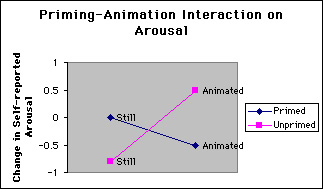Media Effects Research Lab - Research Archive
Animation and priming effects in online advertising
Student Researcher(s)
Lisa Pisciotta (BA Student) ( Candidate);
George Otto (Masters Candidate);
Karen Schlag (Masters Candidate);
Faculty Supervisor
FOR A COMPLETE REPORT OF THIS RESEARCH, SEE:
Sundar, S. S., Otto, G., Pisciotta, L., & Schlag, K. (1997, July). Animation and priming effects in online advertising. Paper presented to the Advertising Division at the annual conference of the Association for Education in Journalism and Mass Communication (AEJMC), Chicago.
INTRODUCTION
Online users, unlike audiences for traditional media, are neither passive nor captive. Advertisers have tried to make use of the technological possibilities of the web and innovating the art of advertising in the process of trying to attract as many online users as they can. Two recent innovations in online ads are animation and priming. Increasingly, still ads are being replaced by animated ads on the web. Another enticement is the placement of ads in a contextually relevant manner such that online ads are often relevant to the online text that the user has called up on the web. That is, the advertiser is hoping that users are primed by their own interest as well as the non-ad content of the page in a way that will make them more receptive to the ad. The purpose of this study is to examine the psychological effects of both animation and priming in web advertising.
HYPOTHESES
Past research findings indicate that animation results in increased attention. Also, higher levels of attention result in better memory. This leads to the following hypothesis:
H1: Animated version of an online advertisement will be remembered better than the still version of the same ad.
Past findings also indicate that animation also results in increased arousal and subjective evaluations of animated content. This leads to the following hypotheses:
H2: Animated version of an online advertisement will lead to greater arousal than the still version of the same ad.
H3: Animated version of an online advertisement will be evaluated more positively than the still version of the same ad.
Based on prior research findings that suggest that emotionally related primes can influence people's feelings and actions, the following hypotheses were generated:
H4: Participants primed with information about the content of an online ad will have better memory for the content of the ad than those participants who are not primed.
H5: Primed participants will evaluate an online ad more positively than will non-primed participants.
H6: Primed participants will be aroused more by an online ad than will non-primed participants.
METHOD
Forty-one participants took part in a between-participants experiment. Participants were asked to view online news and advertising material on a website. A factorial design was used, with two levels of animation (animated, still) and two levels of priming (primed, non-primed). For two of the groups, instructions included a verbal prime related to the content of the advertisement used in the study. The non-primed groups did not receive a verbal prime. Also, the two primed groups were given a visual prime in the form of a screen saver related to the advertisement when they sat down in front of the computer. Once instructed to begin, participants were led to the modified front page of an online newspaper site. Included among the items was an advertisement designed for the experiment.

RESULTS
H1: Not Supported. The animated version of the online advertisement was not remembered better than the still version of the same ad.
H2: Not Supported. The animated version of the online advertisement did not lead to greater arousal than the still version of the same ad.
H3: Partially supported. Participants in the animated condition rated the ad less of a nuisance and less likely to be confused with news content.
H4: Disconfirmed. Primed participants, on average, remembered significantly lesser material than their non-primed counterparts.
H5: Not Supported. Primed participants did not evaluate the online ad more positively than non-primed participants.
H6: Not Supported. Primed participants were not more aroused by the online ad than non-primed participants.
An interesting interaction effect was also found. Animation and priming seem to have a combined effect on users' arousal such that when both animation and priming are simultaneously present (or completely absent) on a website, they cause a significant decrease in arousal than when one is present and the other absent.

CONCLUSION
The present study offers new directions for comparing new media with traditional media by adequately incorporating structural features of the new medium. It makes an important contribution in documenting the psychological effects of technological features unique to the web. Specifically, it considered animation and priming, and found that these two elements have a combined effect on users' arousal level, but have minimal, if any, effect on users' memory and evaluations.
For more details regarding the study contact
Dr. S. Shyam Sundar by e-mail at sss12@psu.edu or by telephone at (814) 865-2173

